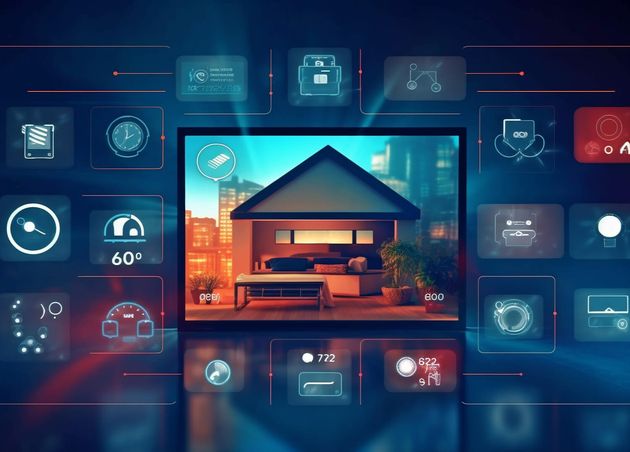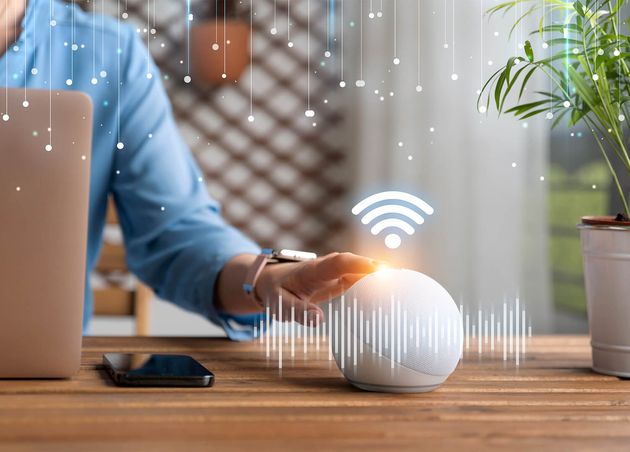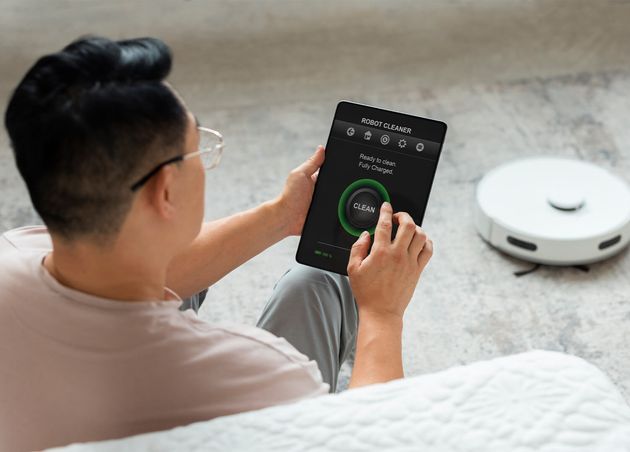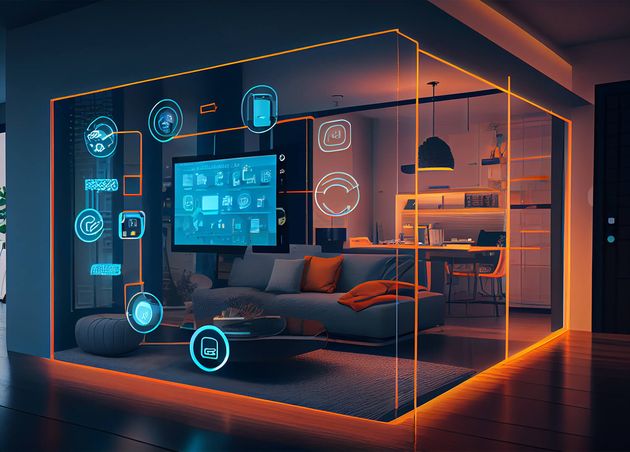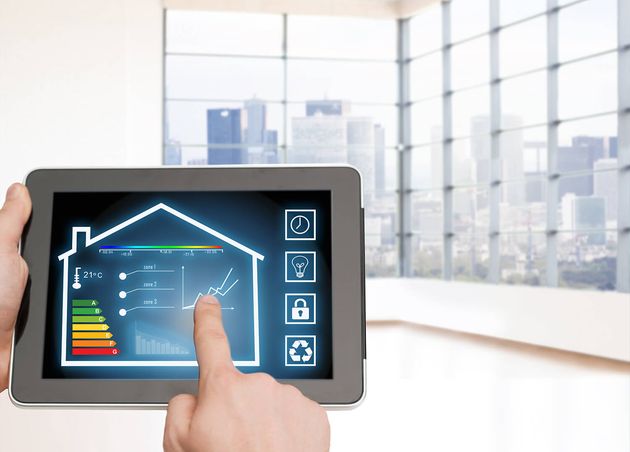
Von der Idee zur Realität: Die Smart-Home-Revolution und darüber hinaus
Die Menschheit ist aufgrund des raschen Fortschritts in Wissenschaft und Technologie in das Informationszeitalter eingetreten. Durch diese Fortschritte leben die Menschen jetzt in komfortableren, sichereren und bequemeren Häusern. Dies hat zur Entstehung von intelligenten Häusern und Gebäuden geführt. Um zentralisierte oder externe Operationen zu handhaben, verwendet ein intelligentes Zuhause ein Heimnetzwerk von Bustechnologiegeräten, die mit Netzwerküberwachungs- und Steuerungsimplementierungsinformationen verbunden sind.
Der aktuelle Trend in der Entwicklung von Smart Homes ist ein Wandel von zentralisierter zu dezentralisierter Steuerung. Derzeit verwenden intelligente Häuser vier gängige drahtlose Technologien: WiFi, Z-Wave, Bluetooth und ZigBee. WiFi- und ZigBee-Technologien sind am wettbewerbsfähigsten.
💻 Technische Tatsache!
Bis 2025 werden 478,2 Millionen Smart Homes auf dem globalen Markt erwartet.
Aufbau eines Smart Homes: Grundlagen und Überlegungen
Der neueste Trend unter jüngeren Hauskäufern sind intelligente Häuser. Diese Häuser werden durch das Internet der Dinge (IoT) betrieben und sollen den Hausbesitzern ein komfortableres Leben und mehr Kontrolle über ihr Eigentum bieten.
Smart-TVs, Sicherheitskameras, Türschlösser, intelligente Beleuchtungssysteme und intelligente Lautsprecher wie Amazon Echo/Alexa sind einige der beliebten intelligenten Haushaltsgeräte. Hausbesitzer können diese elektrischen und elektronischen Geräte jetzt mithilfe von Sprachbefehlen oder einem Smartphone bedienen, alles dank Automatisierung. Diese "intelligenten Häuser" automatisieren nicht nur Aufgaben, um das Leben bequemer zu machen, sondern sparen auch Geld und Energie.
Ein intelligentes Zuhause muss zunächst über eine zuverlässige Hochgeschwindigkeits-Internetverbindung verfügen, um ordnungsgemäß zu funktionieren. Um intelligente Geräte in einem Haus mit aktualisierter Technologie zu betreiben, ist ein unbegrenzter Tarif optimal. Bei der Auswahl eines Internetpakets sollten Sie bedenken, dass Sie neben den intelligenten Geräten in Ihrem Zuhause auch Internetzugang für tägliche Aktivitäten wie Gaming, Streaming von Videos und Büroarbeit benötigen. Bei der Auswahl eines Breitbandpakets für intelligente Häuser sollten Sie beachten, dass all dies eine erhebliche Menge an Daten erfordert.
Gewährleistung nahtloser Konnektivität: Die Rolle von WiFi in Smart Homes
Eine umfassende Wi-Fi-Verbindung ist für den reibungslosen Betrieb eines intelligenten Hauses erforderlich. Dies muss bis zu den Zeiten hoher Internetnutzung oder Spitzenzeiten reichen. Bei der Auswahl eines Breitbandplans sollten Sie Fibernet-Technologie von einem seriösen Internetdienstanbieter mit erstklassigen Download-Geschwindigkeitsoptionen wählen. Unterbrechungsfreie Dienstzuverlässigkeit ist ein zusätzliches Kriterium.
Maximierung der Leistung: Die Bedeutung von Hochgeschwindigkeits-Internet in Smart Homes
Es ist wichtig, ein Hochgeschwindigkeits-Breitband-Internet für Ihre intelligenten Geräte zu haben, damit sie optimal funktionieren. Die meisten intelligenten Haushaltsgeräte benötigen nicht viele Daten, aber Geräte mit Videofunktionen, wie Videotürklingeln und Sicherheitskameras, verwenden viel, einschließlich Daten.
Schutz Ihres Smart Homes: Sicherstellung sicherer Internetverbindungen
Es ist entscheidend, Ihre Internetverbindung vor Malware und Hackern zu schützen, angesichts der steigenden Cyberkriminalität. Verwenden Sie für Ihre Überwachungssysteme und Ihre Wi-Fi-Verbindung sichere Passwörter. Außerdem sollten Sie auf unbefugte Datenverwendung oder Änderungen der Sicherheitseinstellungen achten.
Ein Master-Heimautomatisierungscontroller, ein intelligentes Zuhause-Hub, steuert jedes Gerät, einschließlich Thermostate, Beleuchtung, Sicherheitssysteme und Haushaltsgeräte. Dieser Hardware-Hub, der drahtlos erkennen, analysieren und übertragen kann, dient als Gehirn des intelligenten Heimsystems. Er vereint alle verschiedenen Apps in einer einzigen, fernsteuerbaren Smart-Home-App für Hausbesitzer.
Google Home, Wink Hub und Amazon Echo sind einige Beispiele für intelligente Zuhause-Hubs. Bestimmte intelligente Haushaltsgeräte verlassen sich auf drahtlose Protokolle wie Zigbee oder Z-Wave, während viele andere sich dafür entscheiden, sich über Wi-Fi und Bluetooth mit dem intelligenten Heimnetzwerk zu verbinden.
Verwandeln Sie Ihr Haus in ein Smart Home: Schritt-für-Schritt-Anleitung
Die Umwandlung Ihres Hauses in ein intelligentes Zuhause kann schrittweise oder auf einmal angegangen werden. Unabhängig von Ihrem gewählten Tempo gibt es wesentliche Schritte, um sich auf die nahtlose Integration intelligenter Geräte und Haushaltsgeräte vorzubereiten.
#1 Sorgen Sie für eine solide Grundlage: Investieren Sie in WiFi-Upgrade
Verbessern Sie Ihre WLAN-Infrastruktur, um die Konnektivitätsanforderungen intelligenter Haushaltsgeräte zu unterstützen. Bestätigen Sie, dass Ihr WLAN-Signal robust genug ist, um nahtlosen Datenaustausch zwischen Geräten zu ermöglichen, insbesondere in größeren Häusern. Erwägen Sie, in mehrere Router für erweiterte Abdeckung und verbesserte Konnektivität zu investieren.
#2 Erkunden Sie verfügbare Optionen: Führen Sie gründliche Recherchen durch
Machen Sie sich mit der vielfältigen Palette von intelligenten Haushaltsgeräten und -systemen vertraut. Führen Sie gründliche Recherchen durch, um die Funktionen, Funktionalitäten und Kompatibilität verschiedener Geräte zu verstehen, bevor Sie informierte Entscheidungen treffen.
#3 Bestimmen Sie Bedürfnisse, die mit Ihrem Lebensstil übereinstimmen
Bewerten Sie Ihre spezifischen Anforderungen, Lebensstil und Vorlieben, um festzustellen, welche Aspekte Ihres Zuhauses am meisten von intelligenter Technologie profitieren würden. Priorisieren Sie Bereiche, die sofortige Aufmerksamkeit erfordern, und wählen Sie intelligente Haussysteme, -geräte und -geräte aus, die Ihren Bedürfnissen und Ihrem Lebensstil entsprechen.
#4 Anpassung an bestehende Häuser: Retro-Optionen in Betracht ziehen
Intelligente Technologien können nahtlos integriert werden, egal ob Sie in einem neu gebauten Haus oder in einem älteren Gebäude wohnen. Die Nachrüstung intelligenter Geräte in bestehende Häuser ermöglicht die Modernisierung der Infrastruktur und die Integration modernster Automatisierungslösungen.
#5 Erkunden Sie Automatisierungstechnologien und wählen Sie die richtigen Protokolle
Machen Sie sich mit verbreiteten Kommunikationstechnologien für die Hausautomatisierung wie Z-Wave und Zigbee vertraut. Diese Technologien nutzen Kurzstrecken-Funkübertragungen mit geringem Energieverbrauch und Mesh-Netzwerkfähigkeiten, um intelligente Haussysteme effizient zu verbinden.
#6 DIY oder vorgefertigte Lösungen: Maßgeschneidert oder fertig zum Einbau
Erkunden Sie den Aufbau benutzerdefinierter Smart-Home-Systeme mithilfe von Plattformen wie Raspberry Pi oder entscheiden Sie sich für vorgefertigte Smart-Home-Kits mit allen erforderlichen Komponenten für eine einfache Installation und Einrichtung. Wählen Sie den Ansatz, der am besten mit Ihren technischen Fähigkeiten und Projektanforderungen übereinstimmt.
Beste Praktiken für Smart Homes: Wichtige Maßnahmen für Hausbesitzer
Die Konfiguration eines intelligenten Hauses kann Herausforderungen mit sich bringen, aber Hausbesitzer können den Prozess effektiv bewältigen, indem sie die folgenden wesentlichen Maßnahmen berücksichtigen:
#1 Sorgen Sie für eine solide Grundlage: Investieren Sie in zuverlässiges Internet
Priorisieren Sie den Erwerb einer robusten und zuverlässigen Internetverbindung, da diese das Rückgrat der Konnektivität eines intelligenten Hauses bildet. Entscheiden Sie sich für schnellen und zuverlässigen Zugang, um eine nahtlose Kommunikation zwischen Geräten zu unterstützen.
#2 Wählen Sie den richtigen Hub: Zentralisieren Sie die Steuerung
Wählen Sie einen intelligenten Zuhause-Hub, der wirklich Ihren Automatisierungsbedürfnissen und -vorlieben entspricht. Ein Hub, der in der Lage ist, alle Geräte ferngesteuert zu verwalten, bietet umfassende Kontrolle, während virtuelle Assistenten wie Amazon Echo eine sprachgesteuerte Funktionalität für zusätzlichen Komfort bieten.
#3 Bauen Sie eine bessere Grundlage: Beginnen Sie mit den Grundlagen
Automatisieren Sie Aufgaben im Haus, indem Sie sich auf grundlegende intelligente Haushaltsaccessoires wie Schalter, intelligente Steckdosen und Glühbirnen konzentrieren. Diese einfach zu installierenden Geräte erleichtern eine schnelle Einrichtung und Bedienung und legen den Grundstein für eine fortgeschrittenere Automatisierung.
#4 Priorisieren Sie den Schutz: Sichern Sie Ihre Geräte
Implementieren Sie robuste und effektive Sicherheitsmaßnahmen, um Ihre IoT- und intelligenten Haushaltsgeräte vor unbefugtem Zugriff zu schützen. Richten Sie starke Passwörter ein und verwenden Sie die Zwei-Faktor-Authentifizierung, um sensible Daten zu schützen und potenzielle Verstöße zu verhindern.
#5 Verbessern Sie Ihr Smart-Home-Erlebnis: Erweitern Sie Ihr Geräteportfolio
Führen Sie nach und nach zusätzliche Geräte wie Kameras, Sicherheitssysteme und Videotürklingeln ein, wenn Sie sich mit der Einrichtung des intelligenten Hauses wohler fühlen. Erkunden Sie das Potenzial von ausgelösten und zeitgesteuerten Ereignissen, um Routineaufgaben zu automatisieren und den Komfort zu verbessern.
#6 Nutzen Sie intelligente Lösungen: Nehmen Sie künstliche Intelligenz an
Integrieren Sie künstliche Intelligenz und maschinelles Lernen in Ihre intelligenten Haussysteme. Virtuelle Assistenten (z. B. Google Home, Amazon Echo usw.) passen sich an Benutzerpräferenzen und Routinen an und passen das intelligente Zuhause-Erlebnis entsprechend an.
Vorantreiben der Infrastruktur: Die Rolle intelligenter Gebäude
Intelligente Gebäude sind eine Kategorie, die sich von intelligenten Häusern unterscheidet, obwohl jedes intelligente Zuhause unter das Dach eines intelligenten Gebäudes fällt. Verschiedene Arten von Strukturen, einschließlich großer und kleiner Bürogebäude, Apartmentkomplexe, Wolkenkratzer, Mehrmieterbüros und Wohnhäuser, übernehmen IoT-Technologien, um Ziele wie die Reduzierung von Energiekosten, die Verbesserung der Gebäudeeffizienz, die Minimierung der Umweltauswirkungen, die Verbesserung der Sicherheit und die Steigerung der Zufriedenheit der Bewohner zu erreichen.
Viele Funktionen, die in intelligenten Häusern zu finden sind, wie Energiemanagement und Beleuchtungssteuerung, HVAC-Steuerung, Sicherheitssysteme und Zugangssysteme zu Gebäuden, werden auch in intelligenten Gebäuden implementiert. Beispielsweise können intelligente Gebäude Sensoren verwenden, um Raumbelegungsniveaus zu überwachen und die Temperatur entsprechend anzupassen, um den Energieverbrauch zu optimieren. Wenn ein Konferenzraum überfüllt ist, kann das System Kühlmechanismen aktivieren, und wenn die Mitarbeiter den Tag verlassen, kann es Einstellungen anpassen, um Energie zu sparen.
Intelligente Gebäude-Framework: KI und vorausschauende Wartung
Das Framework für intelligente Gebäude ist zunehmend auf KI und maschinelles Lernen angewiesen. Die Integration mit dem intelligenten Netz ermöglicht eine nahtlose Kommunikation zwischen intelligenten Gebäudekomponenten und dem Stromnetz, wodurch eine effizientere Energieverteilung, proaktive Wartung und eine beschleunigte Abwicklung von Stromausfällen ermöglicht wird.
Vorausschauende Wartung ist ein wesentlicher Vorteil von intelligenten Gebäuden und ermöglicht es Managern und Eigentümern, Wartungsbedarfe vorherzusehen und präventiv zu beheben. Zum Beispiel können Toilettenbedarfsmittel basierend auf Benachrichtigungen von Nutzungssensoren, die niedrige Mengen an Seife oder Papierhandtüchern erkennen, umgehend nachgefüllt werden. Ebenso können Wartungsprobleme bei Beleuchtung, Aufzügen und Kühlsystemen prognostiziert und behoben werden, bevor sie eskalieren.
💻 Techniktrivia!
Weltweit gibt es etwa 300 Millionen intelligente Haushalte.
Die Zukunft umarmen: Die Evolution von Smart Homes und WiFi-Technologie
Die Verwendung von WiFi-Technologie zur Steuerung von Haushaltssystemen über Smartphones wird eine bedeutende Rolle im Leben der Menschen spielen, da intelligente Häuser weiterentwickelt werden und WiFi-Technologie sich weiterentwickelt. Eine zunehmende Anzahl von Unternehmen beteiligt sich an der Entwicklung von intelligenten Haushaltsgeräten.
Intelligente Häuser vereinfachen Aufgaben durch die Nutzung technologischer Fortschritte und Innovationen. Sie haben vollständig verändert, wie Menschen leben, Energie nutzen und mit Haushaltsgeräten interagieren. Beispiele für diese Innovationen sind das Planen von Aufgaben zur Erledigung von Aufgaben zu bestimmten Zeiten oder die Verwendung Ihres Telefons zur Verwaltung von Anwendungen.
Die Möglichkeiten und Kombinationen im faszinierenden neuen Bereich der intelligenten Haustechnologien scheinen grenzenlos zu sein. Die Dienstleistungen und wie sie sich auf Ihr tägliches Leben auswirken, werden mit dem Wachstum der Smart-Home-Branche wachsen.
Tech Bear


